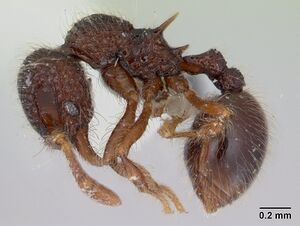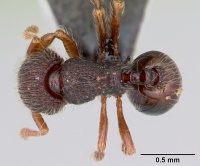Lachnomyrmex scrobiculatus
| Lachnomyrmex scrobiculatus | |
|---|---|

| |
| Scientific classification | |
| Kingdom: | Animalia |
| Phylum: | Arthropoda |
| Class: | Insecta |
| Order: | Hymenoptera |
| Family: | Formicidae |
| Subfamily: | Myrmicinae |
| Tribe: | Attini |
| Genus: | Lachnomyrmex |
| Species: | L. scrobiculatus |
| Binomial name | |
| Lachnomyrmex scrobiculatus Wheeler, W.M., 1910 | |
Lachnomyrmex scrobiculatus is a relatively common species. Workers and gynes occur in samples of sifted leaf litter from the forest floor in different elevations (100–1100m). Michael Kaspari collected a specimen at a barley bait in the La Selva successional plots, Costa Rica (Longino 2007).
Identification
Feitosa and Brandão (2008) - Body densely covered by continuous irregular rugae; metanotal groove obsolete; teeth of propodeal lobes widen basally; petiolar node subtriangular; dorsum of postpetiole convex and strongly rugose; first tergite of gaster entirely covered by long flexuous hairs.
This species is uniquely characterized by the pattern of sculpturation, absence of an impressed metanotal groove, and the presence of the small subpostpetiolar process. Gynes are somewhat more generalized morphologically (see Lachnomyrmex pilosus).
Keys including this Species
Distribution
Southern Mexico (Chiapas) throughout continental Central America to southern Panama.
Latitudinal Distribution Pattern
Latitudinal Range: 18.58333333° to -19.6°.
| North Temperate |
North Subtropical |
Tropical | South Subtropical |
South Temperate |
- Source: AntMaps
Distribution based on Regional Taxon Lists
Neotropical Region: Belize, Costa Rica, Ecuador, Guatemala (type locality), Honduras, Mexico, Panama.
Distribution based on AntMaps
Distribution based on AntWeb specimens
Check data from AntWeb
Countries Occupied
| Number of countries occupied by this species based on AntWiki Regional Taxon Lists. In general, fewer countries occupied indicates a narrower range, while more countries indicates a more widespread species. |

|
Estimated Abundance
| Relative abundance based on number of AntMaps records per species (this species within the purple bar). Fewer records (to the left) indicates a less abundant/encountered species while more records (to the right) indicates more abundant/encountered species. |

|
Biology
|
Castes
Images from AntWeb
   
| |
| Worker. Specimen code casent0178637. Photographer April Nobile, uploaded by California Academy of Sciences. | Owned by MIZA, Maracay, Venezuela. |
Nomenclature
The following information is derived from Barry Bolton's Online Catalogue of the Ants of the World.
- scrobiculatus. Lachnomyrmex scrobiculatus Wheeler, W.M. 1910a: 263, fig. 3 (w.q.) GUATEMALA. Wheeler, G.C & Wheeler, J. 1989a: 321 (l.). See also: Feitosa & Brandão, 2008: 40.
Unless otherwise noted the text for the remainder of this section is reported from the publication that includes the original description.
Description
Worker
Feitosa and Brandão (2008) - Lectotype worker. HL 0.65; HW 0.61; ML 0.17; SL 0.38; EL 0.12; WL 0.75; PSL 0.19; PL 0.33; PPL 0.16; GL 0.80; TL 2.86; CI 95; SI 61; OI 19. Workers (n=18). HL 0.60–0.66; HW 0.58–0.65; ML 0.17–0.22; SL 0.36–0.40; EL 0.12– 0.15; WL 0.69–0.76; PSL 0.14–0.19; PL 0.27–0.33; PPL 0.14–0.18; GL 0.74–0.87; TL 2.80–2.99; CI 95–100; SI 58–64; OI 19–24.
Color dark brown to black, with appendages lighter. Body densely covered by vermiculate and somewhat thick rugae, transverse on anterior portion of pronotum, grading to longitudinal on rest of promesonotum, metapleura and lateral faces of propodeum; rugae somewhat longer and longitudinal on head dorsum and relatively sparser on metapleura and lateral faces of propodeum; mandibles with short striae restricted to the most basal portion; in dorsal view, metanotal area with long transversal rugae extending laterally towards metapleura; petiole and postpetiole irregularly rugose. Abundant pilosity, except by dorsal surface of propodeum; petiolar node, dorsum of postpetiole and first gastral tergite covered by long flexuous hairs; pilosity on first tergite of gaster concentrated at the most dorsal portion.
Head usually slightly longer than broad, with vertexal margin minimally convex; frontal lobes relatively well developed and laterally rounded; eyes with about six facets on maximum diameter. Promesonotum moderately convex in profile; metanotal groove obsolete; propodeal spines straight; teeth of propodeal lobes well developed and considerably swollen basally, reaching propodeal spines half-length. Petiolar node elevated and subtriangular, in lateral view; postpetiole strongly convex and with a discrete anteroventral projection.
Queen
Feitosa and Brandão (2008) - (n=5). HL 0.66–0.68; HW 0.65–0.66; ML 0.22–0.24; SL 0.38–0.42; EL 0.16–0.19; WL 0.87–0.88; PSL 0.17–0.20; PL 0.31–0.33; PPL 0.17–0.20; GL 0.96–1.10; TL 3.23–3.36; CI 96–99; SI 57–65; OI 24–29.
Similar to worker; body pilosity considerably denser; eyes with about 12 facets at greatest diameter; wings with the basic pattern of venation for the genus; petiolar peduncle somewhat elongate; petiolar node faintly lower than in the conspecific worker.
Etymology
Feitosa and Brandão (2008) - The species name refers to the presence of the deep antennal scrobes, observed by Wheeler (1910) in the original description of Lachnomyrmex.
References
- Feitosa, R.M. & Brandão, C.R.F. 2008. A taxonomic revision of the Neotropical myrmicine ant genus Lachnomyrmex Wheeler (Hymenoptera: Formicidae). Zootaxa 1890, 1-49.
- Franco, W., Ladino, N., Delabie, J.H.C., Dejean, A., Orivel, J., Fichaux, M., Groc, S., Leponce, M., Feitosa, R.M. 2019. First checklist of the ants (Hymenoptera: Formicidae) of French Guiana. Zootaxa 4674, 509–543 (doi:10.11646/zootaxa.4674.5.2).
- Wheeler, G. C.; Wheeler, J. 1989a [1988]. Notes on ant larvae: Myrmicinae. Trans. Am. Entomol. Soc. 114: 319-327 (page 321, larva described)
- Wheeler, W. M. 1910d. Three new genera of myrmicine ants from tropical America. Bull. Am. Mus. Nat. Hist. 28: 259-265 (page 263, fig. 3 worker, queen described)
References based on Global Ant Biodiversity Informatics
- Dattilo W. et al. 2019. MEXICO ANTS: incidence and abundance along the Nearctic-Neotropical interface. Ecology https://doi.org/10.1002/ecy.2944
- Feitosa, R.M. and C.R.F Brandao. 2008. A taxonomic revision of the Neotropical myrmicine ant genus Lachnomyrmex Wheeler (Hymenoptera: Formicidae). Zootaxa 1890:1-49
- Fernandes, P.R. XXXX. Los hormigas del suelo en Mexico: Diversidad, distribucion e importancia (Hymenoptera: Formicidae).
- Franco W., N. Ladino, J. H. C. Delabie, A. Dejean, J. Orivel, M. Fichaux, S. Groc, M. Leponce, and R. M. Feitosa. 2019. First checklist of the ants (Hymenoptera: Formicidae) of French Guiana. Zootaxa 4674(5): 509-543.
- Gomez V. E. S., and G. Z. González. 2007. Catalogo de Las Hormigas Presentes en El Museo de Historia Natural de la Universidad del Cauca. Popayán : 1-58.
- Goodnight, C. J., and M. L. Goodnight. 1956. Some observations in a tropical rain forest in Chiapas, Mexico. Ecology 37: 139-150.
- INBio Collection (via Gbif)
- Kempf, W.W. 1972. Catalago abreviado das formigas da regiao Neotropical (Hym. Formicidae) Studia Entomologica 15(1-4).
- Longino J. T. L., and M. G. Branstetter. 2018. The truncated bell: an enigmatic but pervasive elevational diversity pattern in Middle American ants. Ecography 41: 1-12.
- Longino J. T., J. Coddington, and R. K. Colwell. 2002. The ant fauna of a tropical rain forest: estimating species richness three different ways. Ecology 83: 689-702.
- Longino J. T., and R. K. Colwell. 2011. Density compensation, species composition, and richness of ants on a neotropical elevational gradient. Ecosphere 2(3): 16pp.
- Longino J. et al. ADMAC project. Accessed on March 24th 2017 at https://sites.google.com/site/admacsite/
- Longino, J.T. 2010. Personal Communication. Longino Collection Database
- Mertl A. L., J. F. A. Traniello, K. Ryder Wilkie, and R. Constantino. 2012. Associations of two ecologically significant social insect taxa in the litter of an amazonian rainforest: is there a relationship between ant and termite species richness? Psyche doi:10.1155/2012/312054
- Sandoval V. E., and G. Zambrano. 2007. Catálogo de las hormigas presentes en el Museo de Historia Natural de la Universidad del Cauca. Taller Editorial de la Universidad del Cauca, Popayán. 60 pp.
- Vásquez-Bolaños M. 2011. Lista de especies de hormigas (Hymenoptera: Formicidae) para México. Dugesiana 18: 95-133

